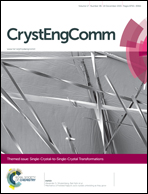Modulating the microporosity of cobalt phosphonates via positional isomerism of co-linkers†
Abstract
By incorporating co-ligands 1,2-bis(imidazol-1-ylmethyl)benzene (1,2-bix), 1,3-bis(imidazol-1-ylmethyl)benzene (1,3-bix) and 1,4-bis(imidazol-1-ylmethyl)benzene (1,4-bix), three isomeric cobalt phosphonates Co5(1,2-bix)2(pbtc)2(H2O)4·8H2O (1), Co5(1,3-bix)2(pbtc)2(H2O)4·7.5H2O (2), and Co5(1,4-bix)2(pbtc)2(H2O)4·6H2O (3) (pbtcH5 = 5-phosphonatophenyl-1,2,4-tricarboxylic acid) have been isolated successfully. Compound 1 shows a layer structure in which chains containing alternately arranged Co3O2 trimers and Co2 dimers are connected by pbtc5− ligands. The 1,2-bix co-ligand adopts a cis-mode, and coordinates to the cobalt atoms from the same chain. Upon dehydration, compound 1 undergoes single-crystal-to-single-crystal (SC–SC) structural transformation forming a new crystal phase Co5(1,2-bix)2(pbtc)2(H2O)4 (1a). The process is reversible upon rehydration, showing a breathing effect. In compounds 2 and 3, similar layers composed of cobalt phosphonate chains and pbtc5− linkages are also found, which are further cross-linked by 1,3-bix or 1,4-bix to form 3D framework structures. The three compounds show different microporosities, as confirmed by their different N2 gas adsorption behaviors.

- This article is part of the themed collection: Single-Crystal-to-Single-Crystal Transformations

 Please wait while we load your content...
Please wait while we load your content...